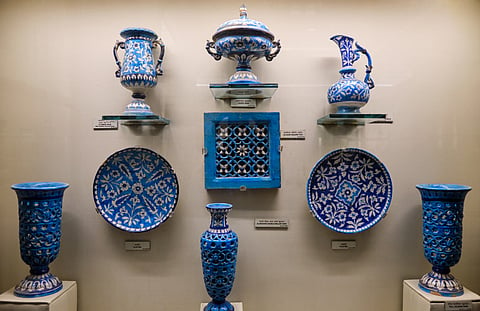
- Destinations
- Experiences
- Stay
- What's new
- Celebrating People
- Responsible Tourism
- CampaignsCampaigns
- SubscribeSubscribe
- Buy Now

Blue pottery, a well-known traditional skill of Jaipur, arrived in the pink city only in the 17th century. The magnificent technique of blue pottery, Turko-Persian in origin, reached East India with Turkish conquests in the 14th century and later flourished under Mughal patronage. The term "blue pottery" refers to the extensive use of cobalt blue dye to give the items a striking tint.
The absence of clay is what distinguishes blue pottery from traditional pottery. Quartz stone powder, powdered glass, borax, gum, Multani mitti (fuller's earth), and water are used to make the dough. In addition, soda bicarbonate can be present in the combination. The finished product is meticulously glazed with Chinese glazing technology.
Blue pottery from Jaipur is instantly recognisable in any local market and is brilliantly decorated in blue and gold colours. These vases are generally decorated with images of birds and animals, such as horses and camels.
Apart from Turkey, the form was established in the 14th century by Mongol painters and later passed to the Chinese, who were inspired by the Persians' buildings and artworks on mosques, palaces, and tombs throughout Central Asia. When the Mughals brought it to India, they began employing it in various constructions, and it was later introduced in Delhi and moved to Jaipur artisans in the 17th century.
From the early 19th-century era, under the reign of Sawai Ram Singh, local artisans were sent to Delhi to be trained in this Indian craft which became a unique art form of Jaipur. Various ancient and ceramic blue pottery works are displayed in Rambagh Palace's museum.
Blue pottery is a thriving art in Jaipur, employing thousands of people. Traditional patterns have been updated, and you can now find tea sets, cups and saucers, plates and glasses, jugs, ashtrays, and napkin rings, in addition to the traditional urns, jars, pots, and vases.
Making blue pottery is a complex and time-intensive procedure. The moulding dough is made by combining the five main ingredients listed above. It is then rolled and flattened into a 4-5 millimetre thick 'Chapatti' (pancake) and placed in moulds with a mixture of fine 'Bajri' (stones) and 'Raakh' (rice) (ash made from burnt wood).
The mould is turned upside down and removed, and the resulting dough is set aside to dry. After cleaning and shaping the pottery, the surface is polished with "Regmaal". It is then dried after being immersed in a solution of quartz powder, powdered glass, edible refined flour (maida), and water. The dried, coated vessel is decorated with a solution of cobalt oxide and edible gum, and the colouring is done using oxides of other metals. These oxides are combined with edible gum and crushed on the stone before being applied with a brush.
Jaipur's blue pottery has evolved significantly in terms of materials, styles, and forms. The raw materials used and making processes have changed over the years. Previously, the glazed coating used on pottery contained lead, but it is now mainly lead-free. In certain regions, diesel furnaces have replaced traditional wood or charcoal-fueled kilns. Fabric or abstract designs are increasingly used instead of classic floral and geometric motifs.
Artisans involved in making blue pottery take a break during the monsoons as the traditional technique of blue pottery requires sun rays for which no work can be done during the rainy season.
Despite these upheavals and changes, Jaipur's ancient, vibrant-blue, glazed ceramic culture remains as beautiful as ever.
Blue Pottery can be purchased in Rajasthali and other stores on MI Road and Amber Road in Jaipur. Blue ceramics can also be bought at Kripal Kumb in Bani Park and Neerja International in Jaipur's C Scheme. Here are some places where you can purchase them.
Address: Near Jain Mandir, Amer Road
Ph: 0141 263 5375
Hours: Closes 9 pm
Address: WQ6Q+4MQ, Jacob Rd, Madrampur, Civil Lines, Jaipur.
Hours: Closes 7 pm
Address: Shop No 138, Hawa Mahal Rd, near Chandi ki taksal
Hours: Closes 10 pm
Address: B-18 A, Shiv Marg, Banipark, Kanti Nagar, Bani Park
Hours: Closes 6 pm
Address: 399A, Gopalpura Bypass Rd
Ph: 098290 06039
Hours: Closes 6 pm
Address: Hotel Rangoli, E5, Mirza Ismail Rd, Panch Batti, New Colony
Ph: 098295 70227
Hours: Closes 7 pm
